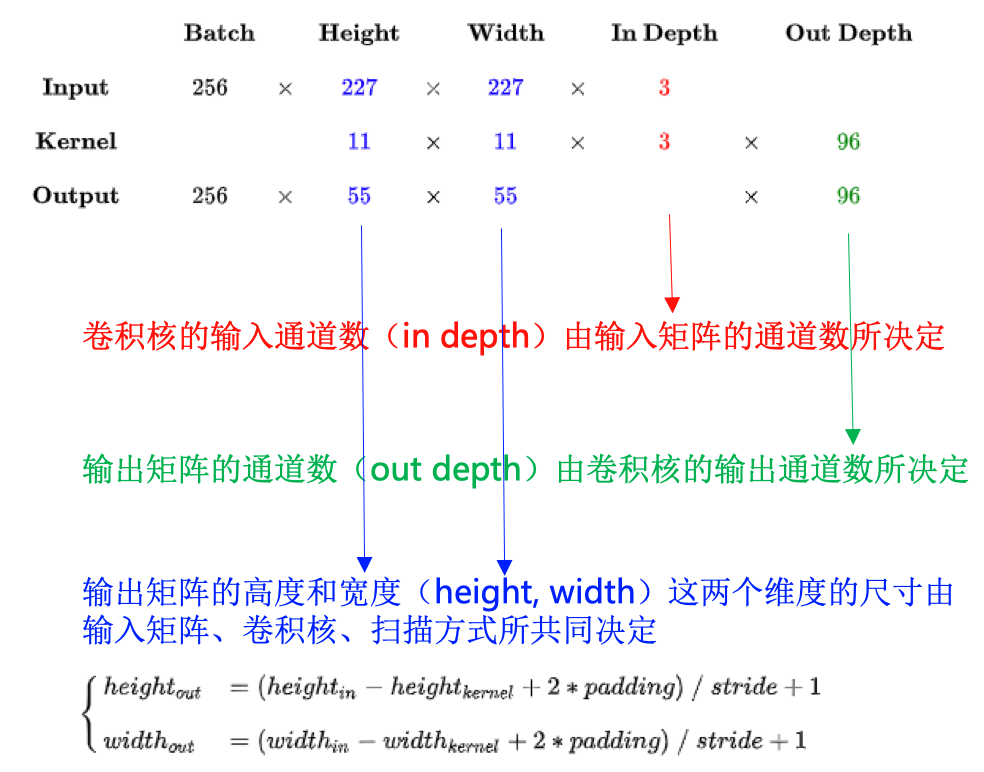目录
概述
卷积神经网络(Convolutional Neural Network, CNN):一种前馈神经网络,在图像处理里面很常用。
概念
1、网络结构(以LeNet5网络为例)

2、概念说明
- 卷积(convolution):使用滤波器(固定权重的一组神经元)与数据做內积(元素相乘再求和)
- 卷积核(convolution kenerl):上面的滤波器,每个含有多个权重,这就是需要训练的参数
- 卷积层(convolutional layer):进行卷积计算的层
- 池化层(pooling layer):通常在卷积层后面,是一种非线性向下采样的方法,主要是减少网络的参数从而减小计算量,有最大池化、平均池化等。
3、卷积计算说明
下面的图说明了设置了两个滤波器,分别和输入的数据做卷积:

卷积计算:
- 卷积核与局部数据进行卷积计算;
- 数据窗口平移,直到计算完所有的数据,此时卷积核是固定不变(共享)的;
- 参数1:深度(depth),神经元个数,同时代表滤波器个数;比如上图中深度为2(有两个神经元)。
- 参数2:步长(stripe),滑动多少步可以到达数据边缘;比如上图是步长为2的,每次滑动为2.
- 参数3:填充值(zaro-padding),在数据外围边缘补充若干圈0,方便从初始位置以步长为单位可以刚好滑倒末尾位置,通俗地讲就是为了总长能被步长整除。 比如上图最外围填充了一圈0.
卷积神经网络计算的特点:
- 局部感知:每次滤波器都是针对某一局部的数据窗口进行卷积
- 参数(权重)共享:数据窗口滑动,导致输入在变化,但中间滤波器的权重(即每个神经元连接数据窗口的权重)是固定不变的。这种特征能极大的减少需要训练的参数,下图是一个比较:

- 这个的出发点是:图片具有静态(stationary)的特征,就是说在一个部分学习的特征可以在其他的部分使用。所以对于大的图片(比如96x96),我们可以先取其上面的小的部分(比如8x8)进行训练学习,然后将学习的特征应用于其他的部分,卷积时参数的共享就是这个得体现。
4、激励函数
ReLU函数:收敛快,求梯度简单,较常用。sigmoid函数:容易饱和、造成终止梯度传递,且没有0中心化,在CNN中不太常用。- 激活函数的总结(Activation function & Activation Functions in Neural Networks):

5、池化层
- 减小网络参数(如果参数超过3M,模型就容易过拟合的)
- 图片的静态性:可用不同位置的聚合特征来描述大的图片
- 不同的pooling方法:max,mean等
6、卷积层尺寸之间的关系
这里以AlexNet模型的第一个卷积层为例:
7、标准卷积 vs 1x1卷积 vs 全连接
示例:LeNet5网络解析
模型解读
LeNet5:美国银行里手写字体数字识别的高校的卷积神经网络模型,涵盖了深度学习的基本模块:卷积层,池化层,全链接层,可把这个作为例子深入解析:

对这个网络里每一层的解释在网络解析(一):LeNet-5详解有详细的说明,具体可参考。这里只对第一层做一下解读,其他的类似。
C1是卷积层,
- 输入:32x32。输入层的图片的像素大小
- 卷积核大小:5x5。【这个是为什么?卷积核的大小是自己预先设定的,可大可小】
- 卷积核数目:6
- 卷积核输出的featuremap大小:28x28。featuremap的大小是由上面的卷积核大小确定的,因为数据在滑动,以所有数据卷积计算完,就知道滑动后有多少个feature。比如这里: 32-5+1=28,32是原始数据大小,5是卷积核大小,这里的步长stripe是1。
- 神经元数量:28x28x6
- 训练参数:(5x5+1) x 6=156。每个卷积核5*5=25个unit参数和一个bias参数,一共6个卷积核。
- 连接数:(5x5+1)x6x28x28 =122304
- 注意:有122304个连接,但是我们只需要学习156个参数,因为卷积核的权值共享。
模型实现
Keras实现LeNet5网络:
# https://github.com/TaavishThaman/LeNet-5-with-Keras/blob/master/lenet_5.py
model = keras.Sequential()
model.add(layers.Conv2D(filters=6, kernel_size=(5, 5), strides = 1, activation='relu', input_shape=(32,32,1)))
model.add(layers.AveragePooling2D())
model.add(layers.Conv2D(filters=16, kernel_size=(5, 5), strides = 1, activation='relu'))
model.add(layers.AveragePooling2D())
model.add(layers.Flatten())
model.add(layers.Dense(units=120, activation='relu'))
model.add(layers.Dense(units=84, activation='relu'))
model.add(layers.Dense(units=10, activation = 'softmax'))
model.compile(optimizer = 'adam', loss = 'categorical_crossentropy', metrics = ['accuracy'])
model.fit(X_train ,Y_train, steps_per_epoch = 10, epochs = 42)
pytorch实现LeNet5网络:
# https://github.com/activatedgeek/LeNet-5/blob/master/lenet.py
import torch.nn as nn
from collections import OrderedDict
class LeNet5(nn.Module):
"""
Input - 1x32x32
C1 - 6@28x28 (5x5 kernel)
tanh
S2 - 6@14x14 (2x2 kernel, stride 2) Subsampling
C3 - 16@10x10 (5x5 kernel, complicated shit)
tanh
S4 - 16@5x5 (2x2 kernel, stride 2) Subsampling
C5 - 120@1x1 (5x5 kernel)
F6 - 84
tanh
F7 - 10 (Output)
"""
def __init__(self):
super(LeNet5, self).__init__()
self.convnet = nn.Sequential(OrderedDict([
('c1', nn.Conv2d(1, 6, kernel_size=(5, 5))),
('relu1', nn.ReLU()),
('s2', nn.MaxPool2d(kernel_size=(2, 2), stride=2)),
('c3', nn.Conv2d(6, 16, kernel_size=(5, 5))),
('relu3', nn.ReLU()),
('s4', nn.MaxPool2d(kernel_size=(2, 2), stride=2)),
('c5', nn.Conv2d(16, 120, kernel_size=(5, 5))),
('relu5', nn.ReLU())
]))
self.fc = nn.Sequential(OrderedDict([
('f6', nn.Linear(120, 84)),
('relu6', nn.ReLU()),
('f7', nn.Linear(84, 10)),
('sig7', nn.LogSoftmax(dim=-1))
]))
def forward(self, img):
output = self.convnet(img)
output = output.view(img.size(0), -1)
output = self.fc(output)
return output
参考
- CNN笔记:通俗理解卷积神经网络
- 网络解析(一):LeNet-5详解
- Activation function
- Activation Functions in Neural Networks
- CNN中卷积层的计算细节
If you link this blog, please refer to this page, thanks!
Post link:https://tsinghua-gongjing.github.io/posts/CNN.html
Previous:
Perl related info
Next:
RNN
Latest articles
Links
- ZhangLab , RISE database , THU life , THU info
- Data analysis: pandas , numpy , scipy
- ML/DL: sklearn , sklearn(中文) , pytorch
- Visualization: seaborn , matplotlib , gallery
- Github: me

